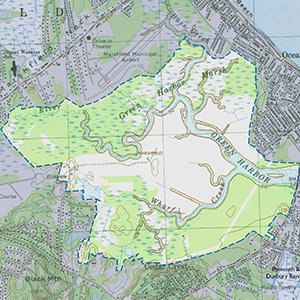Important Bird Area Sites in Massachusetts
Important Bird Area: Daniel Webster Wildlife Sanctuary and Cherry Hill
Site Summary
Nominated By
David Clapp
Size
650 acres
Towns and Counties
Marshfield; Plymouth
Ownership
Mass Audubon
Major Habitats
80% cultural grassland 5% early successional shrubland 5% emergent freshwater wetland 5% palustrine wooded swamp 5% river/stream
Land Use
nature & wildlife, conservation/land trust
Serious Threats
invasive plants
IBA Criteria
- Category 1: Sites important for long-term research and/or monitoring projects that contribute substantially to ornithology, bird conservation, and/or education.
- Category 2: Sites containing assemblages of species characteristic of a representative, rare, threatened, or unique habitat within the state or region.
- Category 4: Single-species Concentrations: The site regularly supports significant concentrations of a flocking species, but may not meet the thresholds above. The site should support a higher proportion of a species' statewide population (more than 1%, if known) than other similar sites.
- Category 5: Seabirds: The site regularly supports 300 or more pelagic seabirds and/or terns or 3,000 or more gulls at one time. A pelagic site is the actual location being used by seabirds (e.g., Stellwagen Bank) and not the location from which an observer counts seabirds (e.g., Provincetown). Smaller concentrations of less common gulls such as Laughing or Bonaparte's gullswill be considered. Human-made food sources for gulls such as landfills and sewage outflows will not be considered. The designation "seabirds" includes shearwaters, storm-petrels, fulmars, gannets, jaegers, and alcids.
Site Description
This IBA consists of Daniel Webster Wildlife Sanctuary (DWWS - Mass Audubon) and municipal conservation commission property (Cherry Hill). The majority of the IBA, and almost all of the DWWS, is in a human-made polder of about two square miles. This area below sea level was created in 1872 when the Green Harbor River was diked. The river was able to exit the marshes, but the tide was not allowed to flow back into the basin. During the past 130 years, the land has subsided significantly in some areas, and has changed from a salt-water regime to a freshwater system. At present the DWWS is about 500 acres. There are about 450 acres of grasslands. Most of the grasslands have been planted and consist of European pasture grasses Timothy, bromes, orchard, and fescues and reed canary grass. The purpose of the dike was to establish an agricultural parcel. This land has been farmed since the dike was established.
Current Conservation Status
Mass Audubon has two management goals for the DWWS: 1) grassland breeding birds and 2) wintering raptors. At present the grasslands are being invaded by several species, which diminish the grasslands value for the management goals. We are looking at various methods of broadleaf weed control. Annually there are 70 acres mowed for baling. There in another 100 acres mowed annually to keep the woody vegetation from becoming established. In addition, every second year 52 acres are mowed to control woody vegetation. There are five bridges in the 52-acre piece. The town of Marshfield is responsible for the management of the dike doors at the river mouth. The surface of the river is usually held at minus 2.5 inches below mean sea level. When the sluice boards are removed the river can drop to minus 4.5 inches below mean sea level. The later elevation allows groundwater to flow off the land quite rapidly.
Ornithological Significance
The DWWS harbors one state-listed and seven regional high-priority species. The most significant of these is Short-eared Owl: about 10% of Massachusetts' wintering population. There are also nesting Least Bitterns, and Bobolinks (60 to 90 pairs). Several pairs of Eastern Meadowlarks bred in the 1990s, and approximately 75 are counted in migration and 20 in winter. The Northern Harrier was as a confirmed nester once in the past ten years. In the spring when the fields are flooded, large numbers of migrant waterfowl (American Black Duck, 500) have been observed, and hundreds of Bobolinks utilize the area as a stopover site. During spring and fall migration, there are usually significant concentrations of migrating swallows. A Purple Martin colony nests on the property. In winter there are significant concentrations of American Robins and blackbirds.
Other Flora or Fauna of Significance
None listed.
Data Sources
Data is from Christmas Bird Counts
D. Clapp personal observations
Reports in Bird Observer
The personal reports are from experienced birders familiar with the site (D. Clapp, D. Ludlow, and D. Furbish).




